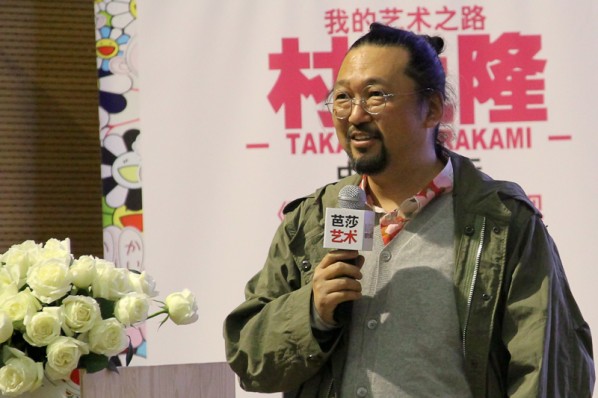Having blurred the traditional lines between art, commerce, pop, and subcultural concerns, Murakami Takashi’s artistic pursuit seems to be boundless. He made his first visit to CAFA on May 17th and also gave a presentation at the Art Museum of Central Academy of Fine Arts, Beijing.
At the start, he introduced his works of the last two decades retrospectively.In addition to producing some of the most iconic paintings and sculptures, his “business-art” activities span from designing a full gamut of consumer merchandise (either for his own Kaikai Kiki label or for fashion houses such as Louis Vuitton and Comme des Garçons) to running the Geisai (an art festival) promotes young Japanese artists which held not only in Japan but also in Taiwan in 2011. His creations of the many preoccupations keep him working on a legendarily nonstop basis. He then talked about how he was inspired from other artists who changes the concrete into the abstract. He also recommended a website—Pixiv which has attracted many artists as well as art lovers to demonstrate their works. When talking about his creation, he thought the indigenous Japanese culture—whether in its reverent, sacred forms, or in more spectacular pop guises—is at the heart of every aspect of his creations. He absorbs them and presents them through his own way. The 49-year-old Murakami said that he always fought with capitalism during his career and he believed that the freedom of artists was constrained by society. He sincerely expressed his thoughts on the relationship between artists and society.

Murakami Takashi
Takashi Murakami was born in 1962 in Tokyo, and received his BFA, MFA and PhD from the Tokyo National University of Fine Arts and Music. He founded the Hiropan factory in Tokyo in 1996, which later evolved into Kaikai Kiki Co., a large-scale art production and art management corporation. In addition to the production and marketing of Murakami's work, Kaikai Kiki Co. functions as a supportive environment for the fostering of young Japanese artists. Murakami is also a curator, entrepreneur, and a critical observer of contemporary Japanese society. In 2000, he organized a paradigmatic exhibition of Japanese art titled "Superflat," which traced the origins of contemporary Japanese visual pop culture to historical Japanese art. He has continued this work in subsequent impactful exhibitions such as "Coloriage" (Fondation Cartier pour l'art Contemporain, Paris, 2002) and "Little Boy: The Art of Japan's Exploding Subcultures" (Japan Society, New York, 2005).
Murakami's work has been shown extensively in group exhibitions around the world, and in one-person exhibitions at leading institutions such as Fondation Cartier pour l'art contemporain, Paris and the Serpentine Gallery, London (2002); Museum of Contemporary Art, Tokyo (2001); Museum of Fine Arts, Boston (2001); and Museum of Contemporary Art, Los Angeles (2007), which traveled to the Brooklyn Museum, the Museum für Moderne Kunst, Frankfurt and opens at Guggenheim Museum, Bilbao February of 2009. His exhibition at the Château de Versailles, France was on view in 2010.
View the Chinese version of this article here




























